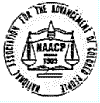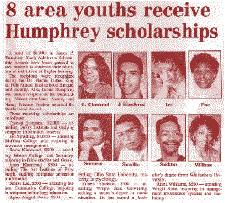|
NAACP
The NAACP is a civil rights
organization in the U.S. that works to end discriminationagainst blacks and other
minority groups. It was founded in 1909 by 60 black and white individuals, and, in 1910,
it bega n to publish a magazine, "Crisis". The publication featured blacks
who had achieved prominence and success in the arts, business, and other fields. n to publish a magazine, "Crisis". The publication featured blacks
who had achieved prominence and success in the arts, business, and other fields.
During the first 30 years of its existence, the association fought against
unjust legal penalties, job discrimination, violence, and for the passage and enforcement
of anti-lynching laws. During World War II
(1939-1945) it focused on achieving equal rights for blacks in the military, and more job
opportunities for black civilians.
After the war, the association renewed its long struggle against the
1896 Plessy v. Ferguson ruling that upheld a policy of "separate but equal"
public facilities for blacks and whites. The decision provided the basis for official
segregation mandates that continued into the second half of the 20th century.
Some of the NAACP’s successes include: Passage of the Civil
Rights Act of 1957 (protects the right to vote), Civil Rights Act of 1964 (embraced equal
opportunity employment), and the Voting Rights Act of 1965 (protects voter registration).
In successive years, the association has worked to strengthen these acts and reach a
variety of educational goals for its young people. The group seeks to reduce the number of
students who drop out of school, encouraging and rewarding academic, scientific, and
artistic excellence among black students.
The NAACP’s income for its multitude of activities comes from
membership fees paid by its more than 400,000 members, approximately 700 youth councils,
and from private donations. Its headquarters are in Baltimore, Maryland, and its
legislative bureau is in Washington, D.C.
In the early 1960s, Frank O’Leary, a Monarch executive, began to
explore the possibility of organizing a local chapter of the NAACP. Determined to succeed,
he consulted with area residents (blacks and whites), analyzing support and forming a
charter committee. The Sidney branch chapter of the NAACP became a reality in 1965 with
CarlKing serving as its first president. James H. Daniel of
Sidney is its current president.
After soliciting the 50 NAACP members that were required, an
election was held. The foundingofficers, in addition to King, were Rufus Sims, Harrison
Brown, James Daniel, and Lucille King. The organization’s initial mission was an
attack on workplace discrimination that existed within some Shelby County industries which
paralleled the subtlehiring practices evident throughout the country during this time
period. Legal actions were taken and some progress secured. Unfortunately, due to a lack
of membership renewals, the group relinquished its charter.
In 1971, the chapter was reorganized and its boundaries were
extended to cover the entire counties of Shelby, Miami, and Logan, The resurgent group was
renamed the Ohio Tri-County NAACP, and to its struggle against discrimination in hiring,
were added court room and unfair housing practices.
The organization’s
goals primarily parallel those of the national NAACP, with local emphasis in the area of
school academics, voter education/registration, and equal opportunity/employment.
The James P. Humphrey Sidney-Shelby County
Black Achievers’ Scholarship Committee wasorganized January 29, 1987, and was
composed of  Dorothy A. Franklin, Chairman; Virginia Thompson, Secretary-Treasurer;James
P. Humphrey, James Daniel, Rev. Claudie Johnson, Dale Locker, Sr., and Kenneth Ruth. This
committee was charged with theresponsibility of administering a scholarship program
established by the community. The funds are awarded in recognition of Humphrey’s
commitment to excellence in education, black history, community service (he was
Sidney’s first black mayor), and his deep dedication to religious beliefs. Black
Achiever awards are also given to adults who are dedicated to improving the "quality
of life" in their communities. Dorothy A. Franklin, Chairman; Virginia Thompson, Secretary-Treasurer;James
P. Humphrey, James Daniel, Rev. Claudie Johnson, Dale Locker, Sr., and Kenneth Ruth. This
committee was charged with theresponsibility of administering a scholarship program
established by the community. The funds are awarded in recognition of Humphrey’s
commitment to excellence in education, black history, community service (he was
Sidney’s first black mayor), and his deep dedication to religious beliefs. Black
Achiever awards are also given to adults who are dedicated to improving the "quality
of life" in their communities.
The Frank O’Leary Award was established to
preserve the memory of the man responsible for the group’s inception, and his
relentless pledge to equality for all citizens. The award is given to those white
individuals, who in the spirit of Frank O’Leary, have shown excellent leadership in
the area of vocational opportunity and equal treatment. The prestigious award has been
presented on three occasions to the following recipients: Matthew Diggs (Copeland
executive); Richard Pope (Stolle executive); and Dale Lochard (Stolle Manager).
All funding for the local chapter’s programs is derived from
membership fees and private donations.
'Black History' segment
written in June, 1998 by David Lodge
[ Back to Black History Index ]
|

